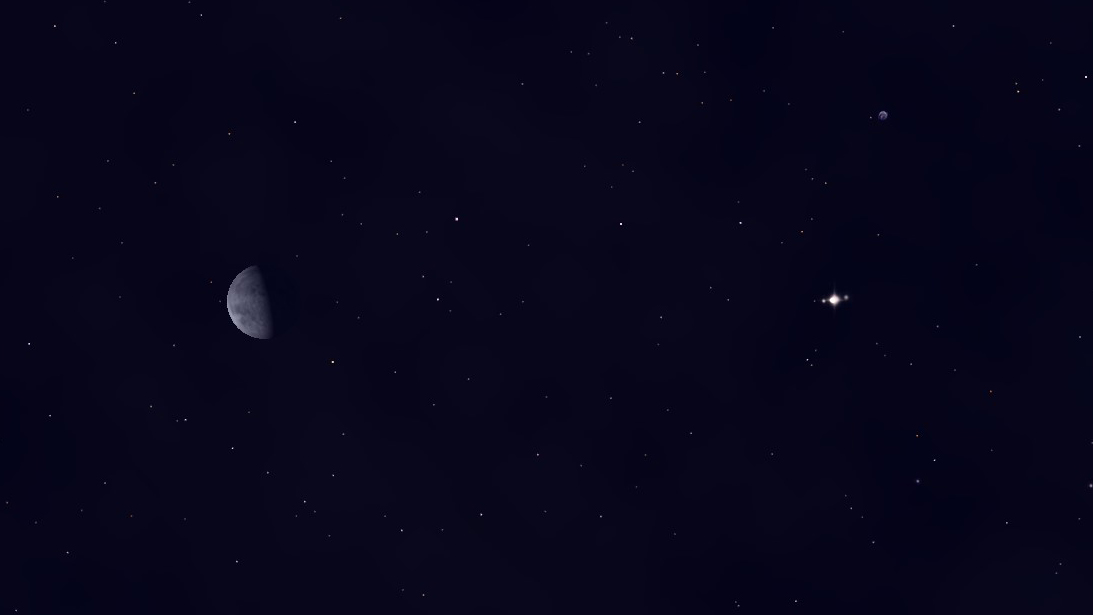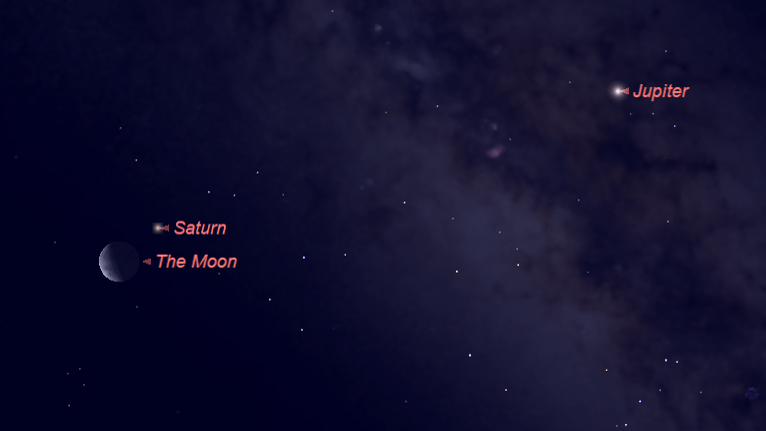See Jupiter Near the Moon Wednesday Morning
The waning moon will make a close approach to Jupiter in the night sky tonight (March 26), and you can see the giant gas planet shining close to Earth's natural satellite early tomorrow morning.
Jupiter will be in conjunction with the moon tonight at 10:28 p.m. EDT (0228 GMT on March 27). When two bodies are in conjunction, they share the same right ascension, or the celestial equivalent of longitude. The moon will actually appear closest to Jupiter 26 minutes after the conjunction at 10:54 p.m. EDT (0254 GMT).
Skywatchers in the U.S. won't be able to see this celestial pair at the moment of conjunction, because Jupiter will be below the horizon. However, the planet will still appear pretty close to the moon when it rises in the morning.
Related: When, Where and How to See the Planets in the 2019 Night Sky
Observers in New York City can see Jupiter rise from the southeast horizon on Wednesday at 1:32 a.m. local time. It will reach its highest point in the sky at 6:14 a.m., when it will be 26 degrees above the southern horizon, according to the skywatching site In-The-Sky.org. (For reference, 10 degrees is approximately the width of your fist held at arm's length.)
Jupiter will set in New York City at 10:54 a.m., which is about 20 minutes before the moon sets, according to timeanddate.com. Once the sun rises at 6:48 a.m., it will be difficult to spot Jupiter through the sun's glare. (You can find out exactly when the sun, moon and planets will be visible from your location using timeanddate.com's visible planets calculator.)
Jupiter will be just a few degrees to the right of the moon in the morning sky on Wednesday. The planet will be in the constellation Ophiuchus, the Snake Bearer, located to the left of Ophiuchus' "foot." Meanwhile, the moon will be the constellation Sagittarius, the Archer.
Breaking space news, the latest updates on rocket launches, skywatching events and more!
Over the coming nights, the moon will continue to inch deeper into Sagittarius, passing the planet Saturn early Friday morning. It will be in conjunction with Saturn at 1 a.m. EDT (0500 GMT). Again, this celestial pair will be below the horizon for skywatchers in the U.S. at the moment of conjunction, but you can see them in the morning sky for a few hours before sunrise.
In between these two planetary conjunctions, you can also appreciate the moon on its own. On Thursday (March 28), the waning moon will reach last quarter phase, when exactly half of the moon's Earth-facing side is illuminated by sunlight.
Editor's note: If you captured an amazing photo of Jupiter with the moon and would like to share it with Space.com for a story or gallery, send images and comments to managing editor Tariq Malik at spacephotos@space.com.
- Best Night Sky Events of March 2019 (Stargazing Maps)
- Jupiter and the Moon: Dazzling Stargazer Photos
- Spring Arrives with a Lion in the Night Sky
Email Hanneke Weitering at hweitering@space.com or follow her @hannekescience. Follow us on Twitter @Spacedotcom and on Facebook.

Hanneke Weitering is a multimedia journalist in the Pacific Northwest reporting on the future of aviation at FutureFlight.aero and Aviation International News and was previously the Editor for Spaceflight and Astronomy news here at Space.com. As an editor with over 10 years of experience in science journalism she has previously written for Scholastic Classroom Magazines, MedPage Today and The Joint Institute for Computational Sciences at Oak Ridge National Laboratory. After studying physics at the University of Tennessee in her hometown of Knoxville, she earned her graduate degree in Science, Health and Environmental Reporting (SHERP) from New York University. Hanneke joined the Space.com team in 2016 as a staff writer and producer, covering topics including spaceflight and astronomy. She currently lives in Seattle, home of the Space Needle, with her cat and two snakes. In her spare time, Hanneke enjoys exploring the Rocky Mountains, basking in nature and looking for dark skies to gaze at the cosmos.


